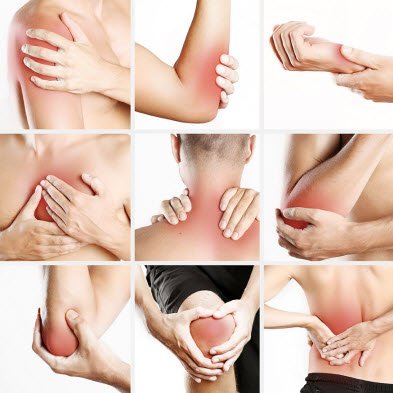Fibromyalgia is a chronic condition that affects muscles and soft tissue, characterized with wide spread pain and tenseness in the body along with fatigue. Fibromyalgia make the person hypersensitive towards the sense of pain. In fibromyalgia patients have been found to have lower levels of a brain neurotransmitter called serotonin, which leads to lowered pain thresholds and increased sensitivity to pain and serotonin promotes a calm and stable mental state also.
Here pain in the tissues is not accompanied by inflammation. Therefore, patients with fibromyalgia do not develop any tissue deformity also does not cause damage to internal body organs.
Fibromyalgia does not progress that fast, the conditions spread slowly and get worsen over the time. It is sometimes referred to as fibromyalgia syndrome and abbreviated FMS. Fibromyalgia was formerly known as fibrositis.
What are the causes of Fibromyalgia?
Doctors and researchers also don’t fully understand the causes of the chronic widespread pain associated with the condition. Some theories suggest it may be that, the brain lowers the pain threshold. Another theory suggests that the nerves and receptors in the body become more sensitive to the pain stimuli. That means they may overreact to pain signals and cause false or exaggerated pain.
So causes of fibromyalgia are still obscure. Medical researchers and doctors don’t know what causes fibromyalgia. Few factors that may contribute to this condition can be listed out as below:
- Ill health: Some times long term illnesses may trigger fibromyalgia or make symptoms of the condition worse.
- Genetic History: Fibromyalgia often runs in families. If you have a family member with this condition, you may have risk for developing it is higher. Certain genetic mutations may play a role in this condition.
- Trauma: People who have under gone any physical or mental trauma and experience post traumatic stress may develop fibromyalgia.
- Stress: As it is well known, stress has been linked to hormonal imbalance and this disturbance can contribute to fibromyalgia.
What are the symptoms of Fibromyalgia?
- Fatigue
- Trouble sleeping
- Sleeping for long periods of time without feeling rested
- Headaches
- Depression
- Anxiety
- Inability to focus or difficulty paying attention
- Pain or dull aching in the lower abdomen
It can also cause problems with memory or concentration, dizziness, numbness and tingling in the hands and feet, sensitivity to bright lights or loud noises, headaches, digestive issues, and dry eyes or mouth.
How to diagnose the Fibromyalgia?
The specific diagnostic criteria of fibromyalgia include widespread pain for at least three months, present almost all over the body, both above and below the waist, as well as the presence of at least 11 of 18 specific tender points, also known as trigger points.
Fibromyalgia overlap with many other disease conditions, this make it difficult to diagnose. Patient has to undergo many medical tests to rule out other conditions before getting a diagnosis of fibromyalgia. A focused protocol is needed for the early diagnoses of fibromyalgia like, patient’s history, physical examination and doctor has to rule out few medical conditions, like, issues related to spine, chronic fatigue syndrome, thyroid function issues, autoimmune disorders etc.
What Ayurveda says about fibromyalgia?
Fibromyalgia can be co related to a vata vyadi (disease, which manifest due to vata vitiation) A vatavyadhi is the disease of chronic and unpredictable nature, usually difficult to cure or some time incurable in nature. It primarily affects the musculoskeletal system and then nervous system, but with the passage of time it starts affecting one or other systems of the body. And this is because the vitiated vata dosha start vitiated pitta and kapha along with dhatus (tissues) .
As per Ayurveda Vata dosha is the one which is responsible for all the movements inside the body. It is said that.
Pittam pangu kapham pangu pangavo mala dhatavaha Vayushch yetra niyante tatra gacchati maghavat (Sharngdhasamhita)
Pitta, kapha, dhatus ( tissues) and malas (metabolic wastes) are lame in the absence of vata. They move with the directions of vata dosha in our body. So if vata is imbalanced, pitta , kapha ,dhatus and malas are also automatically get out off balance. All the activities at grosser or subtler level in our body are carried out by vata only.
Here in case of Fibromyalgia we can co-relate it with vikrut vata lakshnas(sign & symptoms of imbalanced vata) and as mams-medho dhatugat vata(vitiated vata gets lodged in muscles, tendons and adipose tissues) lakshnas. When vata dosha gets out of balance it produces sign and symptoms like pain, stiffness, contracture, fatigue, gradual loss of movement, depletion of sensory functions, delusion, mental disturbance etc.
Mamsa and meda dhatu have similar characteristic both being snigdha (unctuous ), guru( heavy), sthira (stable) guna pradhan(main qualities) which gets vitiated by ruksha (dry), laghu (light)and chala (movable) qualities of vata leading to disorder called Mansamedo dhatugata vata. When we talk about mams-medo dhatugat vata sign and symptoms they are given as follow in the classics.
Guru angaTudyate atyarthamDanda mustihatamShramika atyartham (Charka Chikitsa Sthana)
Gauravam (heaviness), Atyartha toda (excess pain), Danda mushti hatam peeda( severe piercing pain as if beaten with sticks/fist), Saruk (distress), Atyartha Shrama( Excessive exhaustion).
Above two explanations and sign and symptoms explain pathogenesis of fibromyalgia as per Ayurveda. Primarily vata dosha get vitiated and produce various symptoms. Secondly this vitiated vata dosha get lodged to the weaker dhatu (tissues, here these are muscle, tendons and adipose) and produce above sign and symptom.
Our approach to deal with Fibromyalgia
There is no cure, for fibromyalgia as per modern science. Here at Ketav’s Ayush Health Paradise with Classical Ayurveda Panchkarma therapies, we make person’s day to day life easy and comfortable. Also with regular follow up therapies we can stop further progression of disease. A combination of Ayurvedic panchkarma doshas balancing therapies followed by rejuvenation therapies has given amazing results.
Our Classical Ayurvedic treatment plan for fibromyalgia has three objectives.
- To achieve doshas – balance at physical and metal level.
- To detoxify the body and stop the progression of disease.
- To rejuvenate body and mind to have better quality of living.
Such focused approach to deal with fibromyalgia is the only ideal treatment to overcome this dreadful health condition.
Tender points in fibromyalgia and its co-relation with Marma (vital points as per Ayurveda)
Fibromyalgia patients often experience excruciating tenderness at few specific locations across their body. Tenderness is generally present on both sides of the body and is located at 18 (9 in pairs) specific places on the body.
- Low cervical region.
- Front chest area below the collarbone about 2 inches from the shoulder joint.
- Elbow area in the inside of the arm crease.
- Knee area on the inside where the fat pads are present.
- Back of the neck at the base of the skull.
- Back of shoulder area where trapezes muscle drapes over the top of the shoulder.
- Shoulder blade area just at the top of the shoulder blade.
- Rear end at upper outer quadrant of the buttocks.
- Rear hip in the back.

These tender points are nothing but the marma points. Marma points simply defined, as the place in the body where two or more tissues meet, i.e., muscles, vessels, bones, ligaments, tendons bones etc. According to the Ayurvedic treatises there are 107 marma points in the body and plus one is the mind. These are vulnerable to pain and can cause various short or long-term effects to the body even death also.
Above shown tender points can we described as given below in term of Marmas:
- Neela marma – Low cervical region.
- Apastambha marma – Front chest area below the collarbone about 2 inches from the shoulder joint.
- Kurpara marma – Elbow area in the inside of the arm crease.
- Ani marma – Knee area on the inside where the fat pad sits.
- Krikatika marma – back of the neck at the base of the skull.
- Amsa – Back shoulder area where trapezes muscle drapes over the top of the shoulder.
- Amsphalka – Shoulder blade area just at the top of the shoulder blade.
- Katika Tarunam – Rear end at upper outer quadrant of the buttocks.
- Nitamba – Rear hip in the back.
Few tip how to live with fibromyalgia?
- Avoid Vata aggravating causes related to food and lifestyle
- Practice yog, meditation and pranayama (breathing exercises)
- Take good care to avoid exposure, during change of season
- Take recommended herbal supplements regularly to deal with sign and symptoms
- Keep the painful areas in warm comfort and properly moist
- Correct digestion to stop production of Ama (toxins)
- Take proper fluid and water to avoid constipation
- Take care for your sleep, you must sleep adequately
- Opt for an active life style
- Engage your mind into, activities which leads to bliss
We at Ketav’s Ayush Health Paradise giving a ray of hope and positivity to improve health and quality of living, for all who are stuck in the coop of fibromyalgia.
DISCLAIMER: The contents of this document are the opinions of the author based on his/her Ayurvedic knowledge and experience. This document is meant for educational and awareness purposes not for diagnosis or treatment. The suggestions given here are based on the Ayurvedic knowledge and clinical experience. Please consult your Ayurvedic physician before implementing any change in your diet or lifestyle or in supplements.



